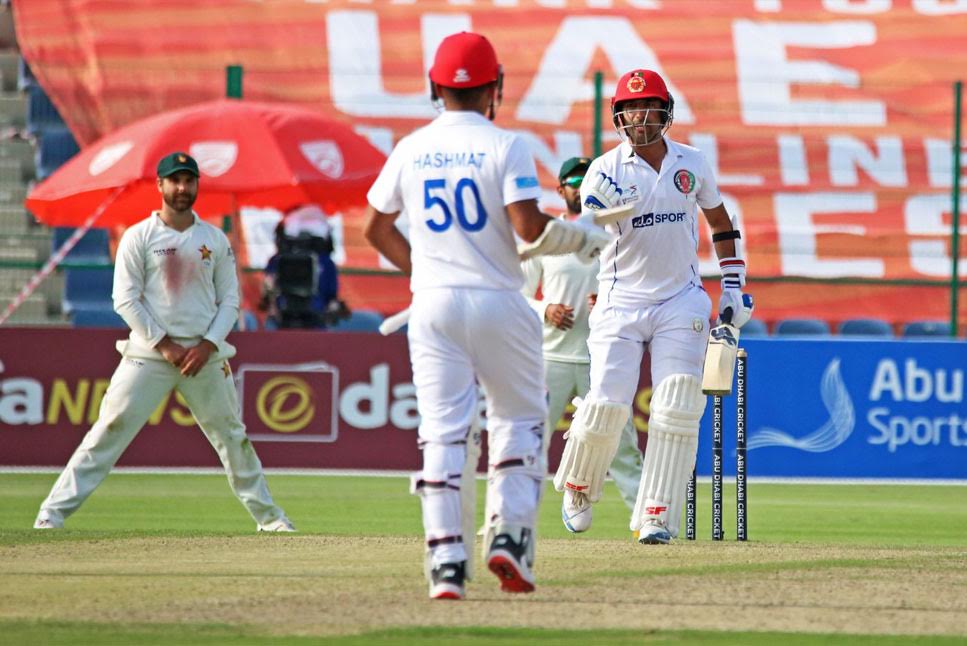Test cricket is colourful yet always dressed in whites, but it is often the unexpected and unconventional that adds to the excitement. In the storied history of Test cricket, six-Test old Afghanistan has managed to add its share of flair and flamboyance, not least after tumbling records in their third victory in the format on Sunday.
To win a Test, let alone by a massive margin, it requires teams to dominate key sessions, bat time and bowl just as effectively. Afghanistan were far from being such an outfit in the first Test against Zimbabwe. Frailties against pace and the moving ball had their batsmen caught like a deer in the headlights.
In a stark contrast from the first Test, which lasted all of two days, Afghanistan regrouped to ensure they batted for the same amount of time in the following Test. At the forefront of an extraordinary turnaround, which saw them rack up 545/4 in the first innings, Hashmatullah Shahidi’s marathon 10-hour double century provided a batting masterclass to his side, one that is constantly evolving and putting the hard yards across all formats.
Arguably, the five-Test old Shahidi, despite having the experience of only 20 first-class fixtures in addition to 41 ODI appearances, batted with the nous of a veteran and is perhaps one of Afghanistan’s most technically correct batsman alongside Rahmat Shah. If one were to wager on who could score the first double century for the country among the two, the odds would have been equal. Although Shah, fittingly christened as the ‘Rolls-Royce of Afghan batting’, became the country’s first centurion against Bangladesh in 2019.
The blueprint laid by the two also rubbed off on skipper Asghar Afghan, who scored his maiden Test hundred (164) on day two last week. Alongside Shahidi, the duo managed to string together a partnership worth 307. What inspired the shift in approach?
“Just two days before the first Test, the team assembled here in Abu Dhabi which was late as some players were held back in Kabul due to visa issues. But having said that, we played poor cricket on our part,” captain Asghar Afghan told a virtual press conference.
“Ahead of the second Test, we played a practice match where we were focused hard on our batting, which was the reason our batsmen performed well in this Test”
“My message to them was simple. Stay at the wicket for long, punish the bad balls and do not hold back your strokes. Since we did not play positive cricket in the first game, our intent in the second Test was positive and gave us the desired result.”
Shahidi and Afghan were watchful in defence early on and exercised caution to not squander away any advantage of batting first on a flattened pitch. However, they did not miss any opportunities to cut the odd loose ball behind square or drive through the covers. Watching them bat was an exercise in watching two highbrows perform a class act.

After an indomitable batting performance, the task for the bowlers was always going to be cut out but as the cracks widened on day three, there was some assistance for spinners Rashid Khan and Amir Hamza who used the variable bounce to good effect bowling Zimbabwe out for 287.
Having enforced the follow on, Afghanistan reduced their African counterparts to 142/7, still 116 runs adrift. Ones in the press might be forgiven for drawing their headlines early with a day four finish imminent. However, Zimbabwe captain Sean Williams and Donald Tiripano teamed up to hand a remarkable riposte in the form of a 187-run partnership.
With the lead on 107, Rashid Khan, who bowled an astounding 99.2 overs in the game, fittingly landed the coup de grâce to pick up his 11th wicket of the match. There was little difficulty in chasing down the target with with six wickets to spare.
Despite a near-complete performance skipper Afghan was keen that his side gleaned from the wide gulf in performances across the two Tests to develop the skills and game required to revel in the longest format.
“We learned a lot from this series in terms of preparation,” he said.
“Next time we will try to conduct preparation camps and four-day games to build our temperament. As we aren’t very experienced in red-ball cricket, we will need to work harder on our skills. There is a huge difference between red-ball skills and white-ball skills.”
Perhaps the series drawn at 1-1 is a fair reflection of good cricket played between the two sides, who put up a show of intent and hunger to play more Tests in the future. For Afghanistan, who are largely associated with T20 cricket, will hope for more game time with a strong desire to play the long game.
“There is no doubt Afghanistan is a strong T20 team but this Test has also made our players and everyone at home love Test cricket,” Afghan said.
“One thing about us Afghans is that we are quick learners therefore I am confident that what other teams have achieved in 30-40 matches, we will take 15-20 matches to do the same.”
In an era of crash-bang-wallop high-on-adrenaline T20 style cricket Afghanistan are known to be a powerhouse for, perhaps watching them take a dogged, doughty, defensive stride forward signifies that they defend more than just a delivery. They defend Test cricket.
You’re reading Emerging Cricket — brought to you by a passionate group of volunteers with a vision for cricket to be a truly global sport, and a mission to inspire passion to grow the game.
Be sure to check out our homepage for all the latest news, please subscribe for regular updates, and follow EC on Twitter, Facebook, LinkedIn and YouTube.
Don’t know where to start? Check out our features list, country profiles, and subscribe to our podcast.
Support us from US$2 a month — and get exclusive benefits, by becoming an EC Patron.








The blueprint laid by the two also rubbed off on skipper Asghar Afghan, who scored his maiden Test hundred (164) on day two last week. Alongside Shahidi, the duo managed to string together a partnership worth 307. What inspired the shift in approach.